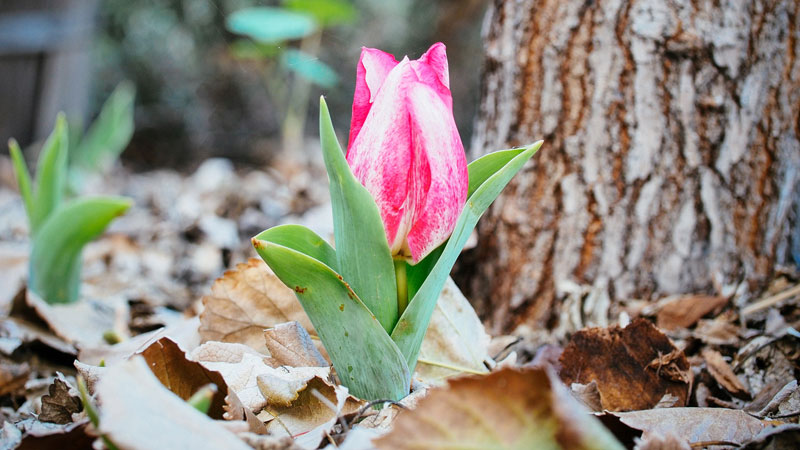


By Linda Ly
Spring officially begins on March 20, but if you’re just getting around to dusting off the trowel and starting your seeds on that day, you’re already late in the game. For a successful season, timing is everything—and when it comes to gardening, the spring season actually starts a few weeks before the vernal equinox arrives. To help you get a head start in the garden, here’s a handy checklist with your pre-season chores.
If it’s still cold and dreary in your part of the country, one of the most satisfying ways to cure that cabin fever is flipping through your favorite seed catalog and marking all the seeds you want to buy. Specialty seeds can sometimes sell out before spring arrives, so make sure you place an order early. Look for varieties specifically marked for “cool season” or “spring planting,” such as snap peas, root vegetables and salad greens.

If the garden-variety tomatoes from your local big-box nursery seem boring, seek out heirloom tomatoes from seed suppliers that specialize in rare or open-pollinated breeds. Start your seeds indoors about six weeks before the last frost in your area, and aim to transplant your tomato seedlings about two weeks after that date. Ensure your seedlings have plenty of sun so they don’t become too leggy (tall and prone to breakage) before they’re ready for the outside world.
Once they’re in the ground, tomatoes prefer less frequent yet very thorough watering that encourages their roots to spread deep in the soil. A general rule of thumb is to soak the soil to a depth of at least six inches once or twice a week, depending on your soil composition and weather conditions. Use a moisture meter or your finger to check—the soil should be damp (but not waterlogged) and should stay damp all day.

If the bulbs you planted in fall are just starting to peek out of the soil but freezing temperatures are still hanging on, add a layer of mulch to protect them until the last frost passes.

As soon as your soil is workable (free of ice crystals and easily crumbled in your hand), start prepping it for early-season planting. Wait for a good rain (or moisten exactly the area you want to weed with an Adjustable Pattern Master Sprinkler) and get to work pulling those pesky first weeds, which release more easily when the ground is damp. Once your garden bed is clear of debris, turn the soil over to aerate it. Break up any clumps, and dig in a layer of well-aged compost.

This time of year, hardy vegetables like spinach, peas, radishes, turnips, leeks and most members of the brassica family (broccoli, cabbage, kale, collards and kohlrabi) can be started from seed or transplanted in the garden. They tolerate cold temperatures (down to the low 20s and high teens) and taste best when they mature in cool weather, so they’re ideal for early spring plantings.
Keep the soil evenly moist, but be careful not to overwater if your area receives a lot of rain. Soil that is too wet can get compacted, cause rotting and encourage pests and diseases, so use the gentle spray function on Gilmour’s watering nozzles to direct moisture exactly where you need it.
Once temperatures reach the high 20s and up, put in semi-hardy vegetables like beets, carrots, rutabaga, cauliflower, lettuce, chard, radicchio and celery. Certain crops, such as radishes, carrots and lettuce, can be succession planted to ensure a continual harvest all season long, so reseed them every two to three weeks until warmer weather arrives.

If you automate your watering with sprinklers and soaker hoses attached to timers, be sure to adjust the timers to account for extended daylight, diminishing rains and warming weather. On the flip side, remember to readjust your timers if the forecast calls for a long period of precipitation—you don’t want to flood your newly seeded or transplanted garden beds. Gilmour’s Dual Outlet Electronic Water Timer is equipped with a Rain Delay feature that allows you to pause your watering schedule when needed, and restart without programming the timer again.
From the moment you pick it up, you’ll notice these nozzles are different. Designed with mobility in mind, they feature Gilmour’s innovative Swivel Connect. The swivel allows the nozzles to pivot without
Learn MoreWinter Gardening Tips to Tackle in the Off Season
As winter marches on, avid gardeners become more and more eager to get growing. While you may not be able to dig your spade into the soil just yet, there is plenty
Learn MoreDesign a Beautiful Drought Resistant Yard
Hot weather and drought-like conditions don’t mean a beautiful yard and garden is out of reach. Learn everything you need to know about drought tolerant landscaping, including the best type of plants,
Get the Dirt